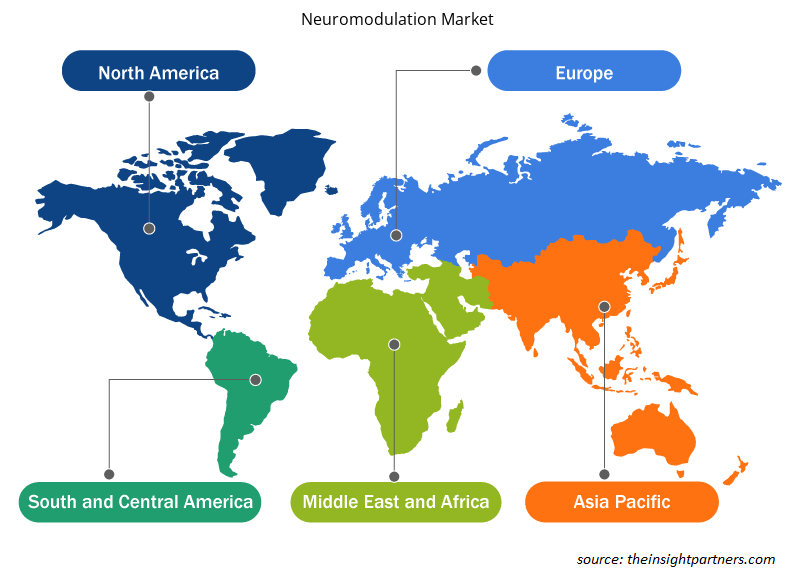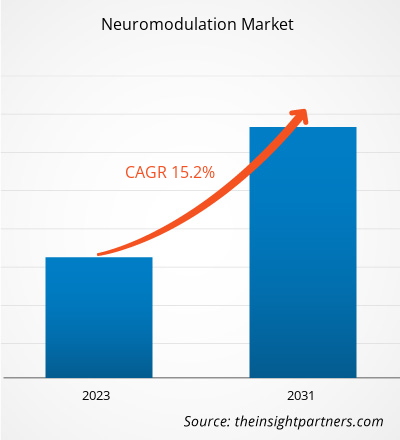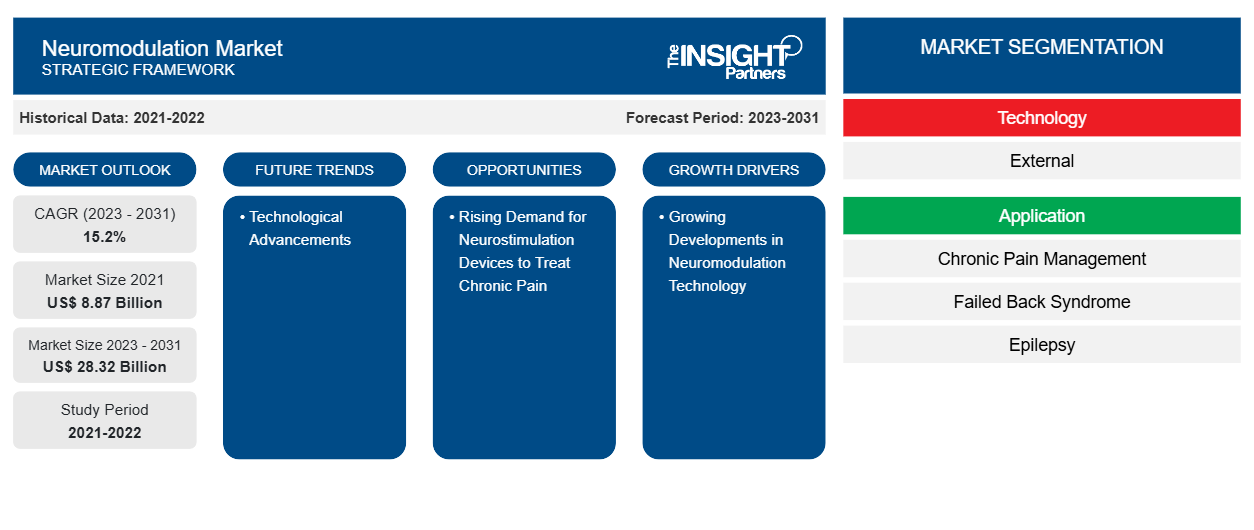La taille du marché de la neuromodulation a été estimée à 8,87 milliards USD en 2021 et à XX milliards USD en 2023 et devrait atteindre 28,32 milliards USD d'ici 2031 ; elle devrait enregistrer un TCAC de 15,2 % en 2023-2031. L'incidence croissante des troubles neurologiques et les développements croissants de la technologie de neuromodulation sont des facteurs déterminants. Les avancées technologiques resteront probablement les principales tendances du marché de la neuromodulation.
Analyse du marché de la neuromodulation
Les dispositifs de neuromodulation contiennent de petites électrodes placées sur la moelle épinière, le cerveau ou les nerfs périphériques. Les troubles neurologiques tels que les maladies cérébrovasculaires, la maladie de Parkinson et la maladie d'Alzheimer ont un impact sur le fonctionnement neurologique de l'organisme et peuvent donc être guéris à l'aide de la neuromodulation. En outre, les entreprises de dispositifs médicaux développent de plus en plus de technologies de neuromodulation et multiplient les programmes de formation pour traiter les troubles neurologiques . Par exemple, en décembre 2023, un programme de formation sur les techniques de neuromodulation en santé mentale a été lancé par le Centre de recherche avancée et d'excellence en neuromodulation pour les professionnels de la santé à l'AIIMS.
Aperçu du marché de la neuromodulation
L'Amérique du Nord est le plus grand marché de la neuromodulation. La croissance est principalement due à l'incidence de maladies neurologiques telles que la maladie de Parkinson, l'épilepsie, la maladie d'Alzheimer et la dépression, entre autres. Par exemple, selon le CDC, le nombre de personnes atteintes de la maladie d'Alzheimer double tous les 5 ans chez les personnes de 65 ans et devrait tripler d'ici 2060 pour atteindre 14 millions de personnes. Parmi tous les groupes ethniques, par rapport aux hommes, les femmes sont près de deux fois plus susceptibles d'être touchées par la maladie d'Alzheimer. De plus, chez les Américains âgés de 65 ans et plus, la maladie d'Alzheimer reste la cinquième cause de décès, ce qui explique que les décès dus aux accidents vasculaires cérébraux, aux maladies cardiaques et au VIH ont augmenté de plus de 145 % entre 2000 et 2019.
Personnalisez ce rapport en fonction de vos besoins
Vous bénéficierez d'une personnalisation gratuite de n'importe quel rapport, y compris de certaines parties de ce rapport, d'une analyse au niveau des pays, d'un pack de données Excel, ainsi que de superbes offres et réductions pour les start-ups et les universités.
-
Obtenez les principales tendances clés du marché de ce rapport.Cet échantillon GRATUIT comprendra une analyse de données, allant des tendances du marché aux estimations et prévisions.
Facteurs moteurs et opportunités du marché de la neuromodulation
Développements croissants dans la technologie de neuromodulation
Les neuromodulateurs modifient l'activité nerveuse en délivrant avec précision des agents électriques ou pharmaceutiques au site cible. Ils sont utilisés à maintes reprises pour soulager la douleur chronique et les progrès technologiques ont multiplié leurs applications. Par exemple, en novembre 2022, CVRx a lancé un nouveau dispositif de neuromodulation pour traiter l'insuffisance cardiaque. Ce dispositif de neuromodulation traite les symptômes de l'insuffisance cardiaque, un nouveau générateur d'impulsions implantable (IPG) Barostim NEO2. Cette deuxième génération réduit la taille de l'IPG de 10 % et prolonge la durée de vie de la batterie de 20 %, réduisant ainsi la fréquence de remplacement de l'appareil pour les patients et leurs prestataires. De plus, en avril 2021, Medtronic a annoncé l'approbation de la FDA pour procéder à un essai d'exemption de dispositif expérimental (IDE) pour évaluer son dispositif de neuromodulation tibiale implantable (TNM) développé en interne, une thérapie destinée à soulager les symptômes de l'incontinence urinaire. alter nerve activity by precisely delivering electrical or pharmaceutical agents at the target site. These are repeatedly used for chronic pain relief and growing technological has increased its applications. For instance, in November 2022, CVRx launched a new neuromodulation device to treat heart failure. This neuromodulation device treats the symptoms of heart failure, a new Barostim NEO2 implantable pulse generator (IPG). This second-generation reduces the size of the IPG by 10% and widens battery life by 20%, thus reducing the device frequency replacements for patients and their providers. Furthermore, in April 2021, Medtronic announced the FDA approval to proceed with an investigational device exemption (IDE) trial to gauge its internally developed implantable tibial neuromodulation (TNM) device, a therapy intended to deliver relief from symptoms of bladder incontinence.
Demande croissante d’appareils de neurostimulation pour traiter la douleur chronique – une opportunitéNeurostimulation Devices to Treat Chronic Pain – An Opportunity
La demande d’appareils de gestion de la douleur augmente chez les personnes âgées et les personnes atteintes d’ostéoporose, de polyarthrite rhumatoïde et d’autres maladies similaires. Selon les recherches du NCBI, en Inde, près de 61 millions de personnes souffrent d’ostéoporose et parmi elles, 80 % sont des femmes. Le pic d’incidence de l’ostéoporose en Inde survient 10 à 20 ans plus tôt que dans les pays occidentaux. Ces maladies nécessitent des appareils de neurostimulation pour traiter la douleur.NCBI research states that in India, almost 61 million people have osteoporosis and out of these, 80% are women. The peak incidence of osteoporosis in India occurs 10–20 years earlier than in Western countries. Such diseases are demanding neurostimulation devices to treat pain.
De plus, plusieurs startups conçoivent des appareils principalement axés sur la thérapie par neurostimulation. Au cours de la thérapie, ces appareils délivrent une stimulation électrique à la moelle épinière , au ganglion de la racine dorsale et au cerveau, ce qui aide à détendre les muscles et à réduire la douleur. Ainsi, les avantages de la thérapie par neurostimulation ont encouragé le développement de produits améliorés sur le marché de la neuromodulation.neurostimulation therapy. During the therapy, these devices deliver electrical stimulation to the neurostimulation therapy have encouraged the development of enhanced products in the neuromodulation market.
L’adoption de dispositifs de neuromodulation a considérablement augmenté dans divers pays d’Amérique du Nord, d’Europe et d’Asie.
Analyse de segmentation du rapport sur le marché de la neuromodulation
Les segments clés qui ont contribué à l’élaboration de l’analyse du marché de la neuromodulation sont la technologie, l’application et les canaux de distribution.
- Sur la base de la technologie, le marché de la neuromodulation est divisé en neuromodulation externe (non invasive) et neuromodulation interne. La neuromodulation externe est en outre sous-segmentée en stimulation électrique respiratoire (RES), stimulation nerveuse électrique transcutanée (TENS) et stimulation magnétique transcrânienne (TMS). En outre, le segment de la neuromodulation interne est également sous-segmenté en stimulation cérébrale profonde (DBS), stimulation nerveuse sacrée (SNS), stimulation électrique gastrique (GES), stimulation de la moelle épinière (SCS) et stimulation du nerf vague (VNS). Le segment de la neuromodulation interne détenait une part de marché plus importante en 2023.
- En fonction des applications, le marché de la neuromodulation est divisé en dépression, dystonie, gestion de la douleur chronique, syndrome du dos défaillant, maladie de Parkinson, épilepsie, tremblements, incontinence, gastroparésie, trouble obsessionnel-compulsif (TOC) et migraine. Le segment de la gestion de la douleur chronique détenait une part de marché plus importante en 2023.
- En fonction de l'utilisateur final, le marché de la neuromodulation est segmenté en hôpitaux, cliniques et soins à domicile. Le segment des hôpitaux détenait une part de marché plus importante en 2023.
Analyse des parts de marché de la neuromodulation par zone géographique
La portée géographique du rapport sur le marché de la neuromodulation est principalement divisée en cinq régions : Amérique du Nord, Asie-Pacifique, Europe, Moyen-Orient et Afrique, et Amérique du Sud/Amérique du Sud et centrale.
L'Amérique du Nord domine le marché de la neuromodulation. La croissance du marché est attribuée aux développements croissants dans le secteur des dispositifs médicaux pour la neuromodulation, à l'augmentation de l'incidence des troubles neurologiques chez les personnes et à la demande croissante de dispositifs de neuromodulation pour la gestion de la douleur chronique. En outre, la charge économique du traitement des troubles neurologiques augmente considérablement dans le pays. L'Asie-Pacifique devrait connaître le TCAC le plus élevé dans les années à venir.
Aperçu régional du marché de la neuromodulation
Les tendances régionales et les facteurs influençant le marché de la neuromodulation tout au long de la période de prévision ont été expliqués en détail par les analystes d’Insight Partners. Cette section traite également des segments et de la géographie du marché de la neuromodulation en Amérique du Nord, en Europe, en Asie-Pacifique, au Moyen-Orient et en Afrique, ainsi qu’en Amérique du Sud et en Amérique centrale.

- Obtenez les données régionales spécifiques au marché de la neuromodulation
Portée du rapport sur le marché de la neuromodulation
| Attribut de rapport | Détails |
|---|---|
| Taille du marché en 2021 | 8,87 milliards de dollars américains |
| Taille du marché d'ici 2031 | 28,32 milliards de dollars américains |
| Taux de croissance annuel composé mondial (2023-2031) | 15,2% |
| Données historiques | 2021-2022 |
| Période de prévision | 2023-2031 |
| Segments couverts |
Par technologie
|
| Régions et pays couverts |
Amérique du Nord
|
| Leaders du marché et profils d'entreprises clés |
|
Densité des acteurs du marché : comprendre son impact sur la dynamique des entreprises
Le marché de la neuromodulation connaît une croissance rapide, tirée par la demande croissante des utilisateurs finaux en raison de facteurs tels que l'évolution des préférences des consommateurs, les avancées technologiques et une plus grande sensibilisation aux avantages du produit. À mesure que la demande augmente, les entreprises élargissent leurs offres, innovent pour répondre aux besoins des consommateurs et capitalisent sur les tendances émergentes, ce qui alimente davantage la croissance du marché.
La densité des acteurs du marché fait référence à la répartition des entreprises ou des sociétés opérant sur un marché ou un secteur particulier. Elle indique le nombre de concurrents (acteurs du marché) présents sur un marché donné par rapport à sa taille ou à sa valeur marchande totale.
Les principales entreprises opérant sur le marché de la neuromodulation sont :
- Abbé,
- Société scientifique de Boston,
- Médtronic,
- NeuroPace, Inc.,
- NeuroSigma, Inc.,
- NEVRO CORP.,
Avis de non-responsabilité : les sociétés répertoriées ci-dessus ne sont pas classées dans un ordre particulier.

- Obtenez un aperçu des principaux acteurs du marché de la neuromodulation
Actualités et développements récents du marché de la neuromodulation
Le marché de la neuromodulation est évalué en collectant des données qualitatives et quantitatives issues de recherches primaires et secondaires, qui comprennent d'importantes publications d'entreprise, des données d'association et des bases de données. Voici une liste des évolutions du marché de la neuromodulation :
- La Food and Drug Administration (FDA) américaine a approuvé le système de stimulation de la moelle épinière (SCS) Eterna d'Abbott pour le traitement de la douleur chronique. Cet appareil offre une expérience améliorée avec la possibilité de se recharger sans fil seulement cinq fois par an, soit la charge de recharge la plus faible par rapport aux autres systèmes SCS rechargeables. (Source : Abbott / Communiqué de presse, décembre 2022)
- GrayMatters Health, développeur de thérapies d'auto-neuromodulation numériques pour les soins de santé mentale, a annoncé le lancement de Prism pour le trouble de stress post-traumatique (TSPT) aux États-Unis. Prism pour le TSPT est le premier dispositif d'auto-neuromodulation à recevoir l'autorisation de la Food & Drug Administration (FDA) des États-Unis en tant que complément prescrit aux soins standard (SOC) pour le TSPT et est accessible dans deux cliniques américaines. (Source : GrayMatters Health, communiqué de presse, janvier 2024)
Rapport sur le marché de la neuromodulation : couverture et livrables
Le rapport « Taille et prévisions du marché de la neuromodulation (2021-2031) » fournit une analyse détaillée du marché couvrant les domaines ci-dessous :
- Taille du marché et prévisions aux niveaux mondial, régional et national pour tous les segments de marché clés couverts par le périmètre
- Dynamique du marché, comme les facteurs moteurs, les contraintes et les opportunités clés
- Principales tendances futures
- Analyse détaillée des cinq forces de PEST/Porter et SWOT
- Analyse du marché mondial et régional couvrant les principales tendances du marché, les principaux acteurs, les réglementations et les développements récents du marché
- Analyse du paysage industriel et de la concurrence couvrant la concentration du marché, l'analyse de la carte thermique, les principaux acteurs et les développements récents
- Profils d'entreprise détaillés
- Analyse historique (2 ans), année de base, prévision (7 ans) avec TCAC
- Analyse PEST et SWOT
- Taille du marché Valeur / Volume - Mondial, Régional, Pays
- Industrie et paysage concurrentiel
- Ensemble de données Excel
Rapports récents
Témoignages
Raison d'acheter
- Prise de décision éclairée
- Compréhension de la dynamique du marché
- Analyse concurrentielle
- Connaissances clients
- Prévisions de marché
- Atténuation des risques
- Planification stratégique
- Justification des investissements
- Identification des marchés émergents
- Amélioration des stratégies marketing
- Amélioration de l'efficacité opérationnelle
- Alignement sur les tendances réglementaires























 Obtenez un échantillon gratuit pour - Marché de la neuromodulation
Obtenez un échantillon gratuit pour - Marché de la neuromodulation